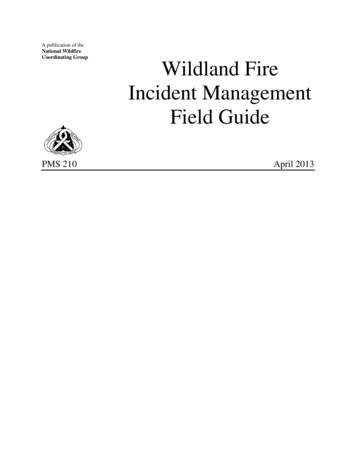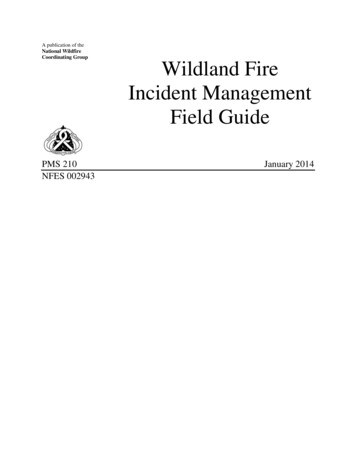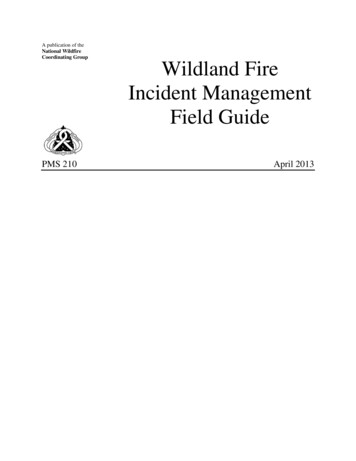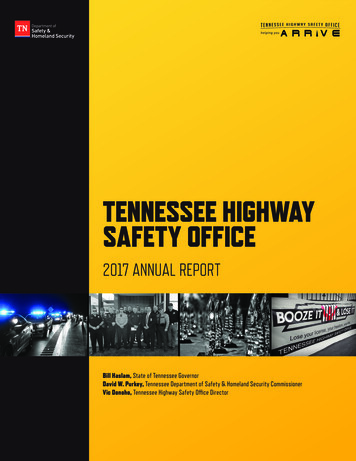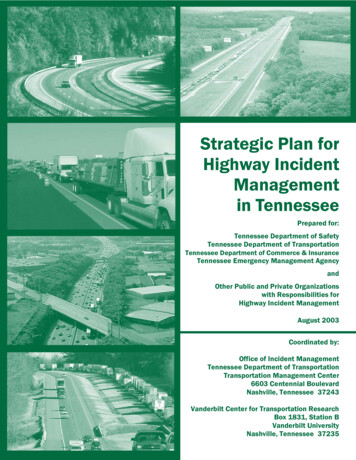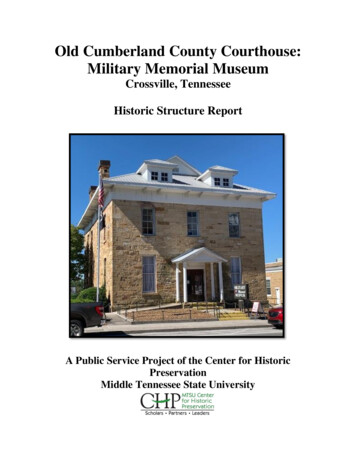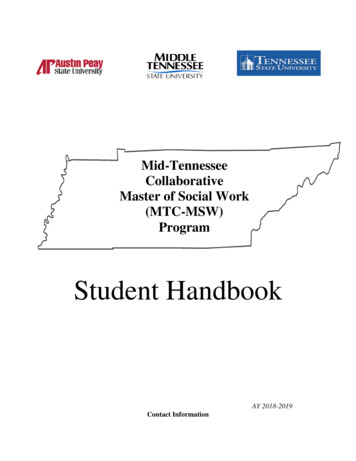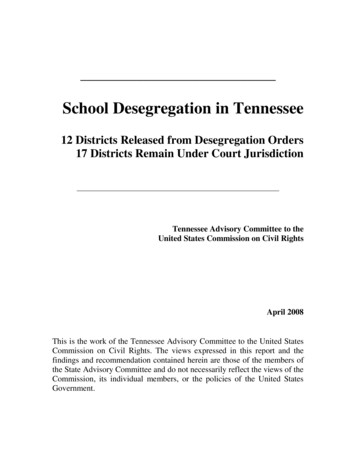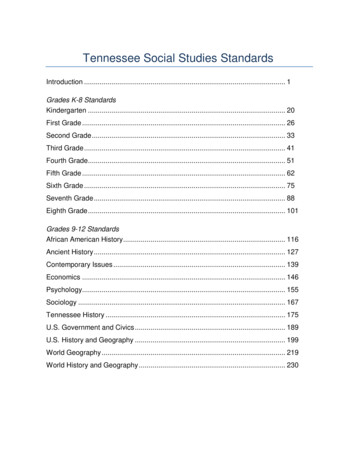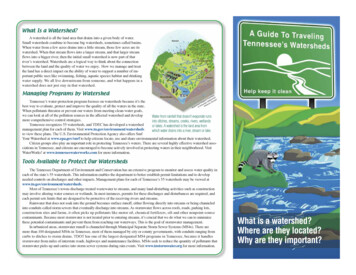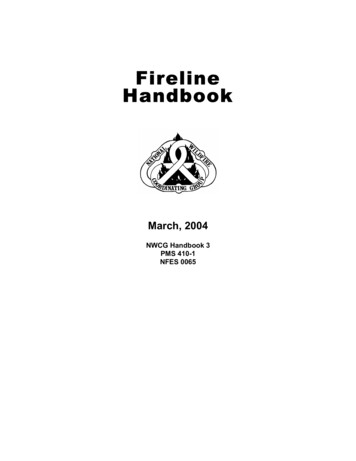
Transcription
FirelineHandbookMarch, 2004NWCG Handbook 3PMS 410-1NFES 0065
STANDARD FIREFIGHTING ORDERS1.Keep informed on fire weather conditions andforecasts.2. Know what your fire is doing at all times.3. Base all actions on current and expected behaviorof the fire.4. Identify escape routes and safety zones, and makethem known.5. Post lookouts when there is possible danger.6. Be alert. Keep calm. Think clearly. Act decisively.7. Maintain prompt communications with your forces,your supervisor and adjoining forces.8. Give clear instructions and insure they areunderstood.9. Maintain control of your forces at all times.10. Fight fire aggressively, having provided for safetyfirst.COMMON DENOMINATORS OFFIRE BEHAVIOR ON TRAGEDY FIRESThere are four major common denominators of firebehavior on fatal and near-fatal fires. Such fires oftenoccur:1.2.3.4.On relatively small fires or deceptively quiet areasof large fires.In relatively light fuels, such as grass, herbs, andlight brush.When there is an unexpected shift in wind directionor in wind speed.When fire responds to topographic conditions andruns uphill.
NWCGFirelineHandbookA Publication of theNational Wildfire Coordinating GroupSponsored byUnited States Department of AgricultureUnited States Department of the InteriorNational Association of State ForestersUnited States Fire AdministrationIntertribal Timber CouncilPrepared byIncident Operations Standards Working TeamMarch, 2004NWCG Handbook 3PMS 410-1NFES 0065Additional copies of this publication may be ordered from:National Interagency Fire CenterATTN: Great Basin Cache Supply Office3833 S. Development Ave., Boise, ID 83705Order NFES #0065
NWCG FIRELINE HANDBOOKMarch Firefighting Safety . 1Initial Attack . 79Extended Attack. 109Large Fire Management Teams . 119Transfer of Command . 125Urban Interface . 135Common Responsibilities . 147Command. 163Operations. 177Air Operations. 193Planning . 225Logistics. 251Finance/Administration. 289Fire Investigation . 305Glossary of Terms. 319Appendix A: GeneralOperational Guides . A-1Appendix B: Fire BehaviorSupplement, October 1993, isprinted and ordered separately . B-1APPENDIX B: ORDER NFES #2165Appendix C: Fire Use . C-1
FIRELINE HANDBOOKCHAPTER 1—FIREFIGHTING SAFETYCONTENTSRISK MANAGEMENT . 4The Risk Management Process . 4Look Up, Down and Around Indicators. 7Tactical Watch-Outs. 8Wildland-Urban Watch-Outs . 9Safety While Protecting Structures FromWildland Fires. 10LCES Checklist . 10Escape Routes and Safety Zones. 12Safety Zone Guidelines . 14Last Resort Survival . 15Downhill Checklist. 17Common Denominators of Fire Behavior onTragedy Fires . 19Thunderstorm Safety . 19Clothing and Personal ProtectiveEquipment (PPE) . 21How to Properly Refuse Risk. 22After Action Review . 24FIREFIGHTER HEALTH. 25Fatigue – Work and Rest. 25Food and Nutrition . 26Firefighter Rehabilitation . 26Driving Limitations . 27First Aid . 28CPR . 30SAFETY FIRST—NO EXCEPTIONSChapter 1 – Firefighting Safety1
Chapter 1 – Firefighting Safety2Carbon Monoxide Poisoning. 31Hypothermia. 33Heat Stress. 34Burn Injury Treatment. 35Burn Notification Procedures. 37Rule of Nine . 38Injury/Fatality Procedures . 38ENTRAPMENT . 40Firefighter Entrapment . 40Fire Shelter Deployment . 40Building Refuge . 44Vehicle Refuge. 45ORGANIZATIONAL . 47General Responsibilities . 47Qualifications . 47Training . 48Supervision of Other Firefighters. 48Safety Officer (SOF1/2/3). 49Fire Behavior Analyst (FBAN) . 49OPERATIONAL GUIDELINES . 49Safety Briefing . 49Fire Weather Forecast . 50Fire Danger Rating . 51Safety Precautions Under ExtremeFire Behavior . 51Night Operations . 53Personnel Transportation . 53Foot Travel . 54Line Scouting . 54Line Construction. 55Safety Flagging Standards . 56Firing Equipment . 57Chain Saws. 57Hazard Trees . 58Hazard Tree Safety . 59
Felling . 59Engine Operations . 60Dozer/Tractor Plow Operations . 61Safety Guidelines . 63Power Line Hazards . 67Suspected Hazardous Materials . 68Incident-Generated HAZMAT. 69Unexploded Ordinance (UXO) . 70UXO Safety and Reporting . 71Helicopter Transportation . 71Aerial Retardant/Helibucket Operations . 73Paracargo Operations . 74Managing Vehicle Traffic UnderSevere Smoke Conditions . 75Essential Incident Response Driving. 78Chapter 1 – Firefighting Safety3
Chapter 1 – Firefighting Safety4RISK MANAGEMENTFIREFIGHTER AND PUBLIC SAFETY IS THE FIRSTPRIORITY OF THE WILDLAND FIRE MANAGEMENTPROGRAM.Remember To: Follow the Standard Firefighting Orders(inside front cover). Recognize the Watch Out Situations (insideback cover). Recognize the Common Denominators of FireBehavior on Tragedy Fires (inside frontcover). Follow the Risk Management Process.The Risk Management ProcessStep 1 - Situation Awareness Gather Information999999 Objective(s)Previous Fire BehaviorCommunicationWeather ForecastWho’s in ChargeLocal FactorsScout the Fire
Step 2 - Hazard Assessment Eliminate Potential Fire Behavior Hazards.9 Look Up, Down and Around Indicators(see page 7)Identify Tactical Hazards.9Watch-Outs (see page 8) What other safety hazards exist? Consider severity vs. probability.Step 3 - Hazard Control Firefighting Orders LCES Checklist –MANDATORY9Anchor Point9Downhill Checklist (if applicable; seepage 17)What other controls are necessary?Chapter 1 – Firefighting Safety5
Chapter 1 – Firefighting Safety6Step 4 - Decision Point Are controls in place for identified hazards?NO – Reassess situationYES – Next question Are selected tactics based on expected firebehavior?NO – Reassess situationYES – Next question Have instructions been given and understood?NO – Reassess situationYES – Initiate actionStep 5 - Evaluate Self: Low experience level with localfactors?– Distracted from primary tasks?– Fatigue or stress reaction?– Hazardous attitude? The Situation: What is changing?– Are strategy and tactics working?
Look Up, Down and Around IndicatorsFire EnvironmentFactorsFuel CharacteristicsAssessFuel MoistureFeel and MeasureFuel TemperatureFeel and MeasureTerrainScoutWindObserveStabilityObserveFire BehaviorWatchIndicatorsContinuous fine fuelsHeavy loading of dead and downLadder fuelsTight crown spacing ( 20 ft.)Special Conditions:Firebrand sourcesNumerous snagsPreheated canopyFrost and bug killUnusual fine fuelsHigh dead to live ratioLow RH ( 25%)Low 10 hr FMC ( 6%)Drought conditionsSeasonal dryingHigh temps ( 85F)High % of fuels w/direct sunAspect fuel temp. increasingSteep slopes ( 50%)Chutes – ChimneysBox canyonsSaddlesNarrow canyonsSurface winds above 10 mphLenticular cloudsHigh, fast-moving cloudsApproaching cold frontsCumulonimbus developmentSudden calmBattling or shifting windsGood visibilityGusty winds and dust devilsCumulus cloudsCastellatus clouds in the a.m.Smoke rises straight upInversion beginning to liftThermal beltLeaning columnSheared columnWell-developed columnChanging ColumnTrees torchingSmoldering fires picking upSmall firewhirls beginningFrequent spot firesChapter 1 – Firefighting Safety7
Chapter 1 – Firefighting SafetyTactical Watch-OutsPosition Building fireline downhill. Building underslung or mid-slope fireline. Building indirect fireline or unburned fuelremains between you and the fire. Attempting frontal assault on the fire, or youare delivered by air to the top of the fire. Terrain and/or fuels make escape to safetyzones difficult.Situation Small fire transitioning to a larger fire or anisolated area of a large fire. Suppression resources are fatigued orinadequate. Assignment depends on aircraft support. Nighttime operations. Wildland-Urban interface operations.EACH OF THESE WATCH-OUTS REQUIRES THATYOU IMPLEMENT APPROPRIATE HAZARDCONTROL(S).8
The safety hazards that exist in a typical protectionof structures from wildland fire assignments aresignificant. In addition to applying THE STANDARDFIREFIGHTING ORDERS and avoiding THE WATCHOUT SITUATIONS, good judgment and planning areextremely important because of the presence ofhomeowners and their families, the media, pets andlivestock, traffic, and unfamiliar combustibles.Wildland-Urban Watch-Outs Poor access and narrow one-way roads Bridge load limits Wooden construction and wood shake roofs Power lines, propane tanks, and HazMatthreats Inadequate water supply Natural fuels 30 feet or closer to structures Structures in chimneys, box canyons, narrowcanyons, or on steep slopes (30% or greater) Extreme fire behavior Strong winds Evacuation of public (panic)Chapter 1 – Firefighting Safety9
Chapter 1 – Firefighting Safety10Safety While Protecting Structures FromWildland FiresStructures exposed to wildland fire in the urbaninterface can and should be considered as anotherfuel type. Size-up and tactics should be basedupon fuels, weather, and topography, just as thosecriteria would be applied to a wildland fire.LCES ChecklistIn the wildland fire environment, Lookouts,Communications, Escape Routes, Safety Zones(LCES) is key to safe procedures for firefighters.The elements of LCES form a safety system usedby firefighters to PROTECT THEMSELVES ANDWORK AS A TEAM WITH OTHERS. This system isput in place before fighting the fire: select alookout or lookouts, set up a communicationsystem, choose escape routes, and select a safetyzone or zones.LCES IS A SELF-TRIGGERING MECHANISM.Lookouts assess and reassess the fire environmentand communicate threats of safety to firefighters.Firefighters use escape routes to move to safetyzones.LCES is built on two basic guidelines:1.Before safety is threatened, each firefightermust be informed how the LCES system willbe used, and2.The LCES system must be continuously reevaluated as conditions change.
Lookouts Experienced/Competent/Trusted Enough lookouts at good vantage points Knowledge of crew location Knowledge of escape and safety locations Map/Weather Kit/Watch/IAPCommunications Radio frequencies confirmed Backup and check-ins established Update on any situation change Sound alarm early, not lateEscape Routes More than one escape route Avoid uphill escape routes Scouted: Loose soils/rocks/vegetation Timed: Slowest person/fatigue andtemperature factors Marked: Flagged for day or night (NFES0566) Evaluate: Escape time vs. rate of spread Vehicles parked for escapeChapter 1 – Firefighting Safety11
Chapter 1 – Firefighting Safety12Safety Zones Survivable without a fire shelter Back into clean burn Natural Features: Rock areas/water/meadows Constructed Sites: Clearcuts/roads/helispots Scouted for size and hazards Upslope? more heat impact larger safetyzone Downwind? more heat impact largersafety zone Heavy fuels? more heat impact largersafety zoneEscape time and safety zone size requirements willchange as fire behavior changes.Escape Routes and Safety ZonesAn Escape Route is “a preplanned and understoodroute firefighters take to move to a Safety Zone orother low-risk area.”A Safety Zone is “a preplanned area of sufficientsize and suitable location that is expected to protectfire personnel from known hazards without usingfire shelters.”
Identification of Escape Routes and Safety Zonesis one of the primary responsibilities of anywildland firefighter working on or near the fireline.The following guidelines can be used whenselecting Safety Zones: Calculations indicate that for most fires, SafetyZones must be wider than 164 feet to ensurefirefighter survival. The calculation to determine Safety Zoneradius is four times the maximum flame heightplus 50 square feet per firefighter, or anadditional four feet of radius per firefighter.This calculation provides the radius of theSafety Zone, meaning the Safety Zonediameter should be twice the value of theabove formula. If potential for the fire to burn completelyaround the Safety Zone exists, the diametershould be twice the values indicated above. Factors that will reduce Safety Zone sizeinclude reduction in flame height by thinningor burnout operations, shielding the SafetyZone from direct exposure to the flame bylocating it on the lee side of ridges or othergeographic structures, or reducing flametemperatures by applying fire retardant to thearea around the Safety Zone. All firefighter PPE must be worn. Keep in mind that these guidelines do notaddress convective energy.Chapter 1 – Firefighting Safety13
Chapter 1 – Firefighting Safety14Safety Zone Guidelines Avoid locations that are downwind from thefire. Avoid locations that are in chimneys, saddles,or narrow canyons. Avoid locations that require a steep uphillescape route. Take advantage of heat barriers such as leeside of ridges, large rocks, or solid structures. Burn out safety zones prior to flame frontapproach. For radiant heat only, the distance separationbetween the firefighter and the flames must beat least 4 times the maximum flame height.This distance must be maintained on all sides,if the fire has ability to burn completelyaround the safety zone. Convective heatfrom wind and/or terrain influences willincrease this distance requirement. Thecalculations in the following table assumeno slope and no wind.
FlameHeight10 ft.20 ft.50 ft.75 ft.100 ft200 ft.Distance Separation(firefighters toflame)40 ft.80 ft.200 ft.300 ft.400 ft.800 ft.Area inAcres1/10 acre1/2 acre3 acres7 acres12 acres50 acresDistance Separation is the radius from the centerof the safety zone to the nearest fuels. When fuelsare present that will allow the fire to burn on allsides of the safety zone this distance must bedoubled in order to maintain effective separationin front, to the sides, and behind the firefighters.Area in Acres is calculated to allow for distanceseparation on all sides for a three person enginecrew. One acre is approximately the size of afootball field or exactly 208 feet x 208 feet.Last Resort SurvivalLook at your options and immediately act on thebest one!Utilize all Personal Protective Equipment!Protect your airway!Escape if you can: Drop any gear not needed for fire shelterdeployment (keep your fire shelter, hand tool,quart of water, and radio). You may be able to use the fire shelter for aheat shield as you move.Chapter 1 – Firefighting Safety15
Chapter 1 – Firefighting Safety16 In LIGHT FUELS, you may be able to moveback through the flames into the black. If you are on the flank of the fire, try to getbelow the fire. Consider vehicles or helicopters for escape.Find a survivable area:Stay out of hazardous terrain features. Use bodies of water that are more than 2 feetdeep. In LIGHT FUELS, you may be able to light anescape fire. In other fuels, you may be able to light abackfire. Call for helicopter or retardant drops. Cut and scatter fuels if there is time. Use any available heat barriers (structure,large rocks, dozer berms). Consider vehicle traffic hazards on roads.Pick a fire shelter deployment site:Find the lowest point available. Maximize distance from nearest aerial fuels orheavy fuels. Pick a surface that allows the fire shelter toseal and remove ground fuels.
Get into the fire shelter before the flame fronthits. Position your feet toward the fire and holddown the fire shelter. Keep your face pressed to the ground. Deploy next to each other and keep talking.Expect:Extremely heavy ember showers. Superheated air blast to hit before the flamefront hits. Noise and turbulent powerful winds hitting thefire shelter. Pin holes in the fire shelter that allow fire glowinside. Heat inside the shelter Extreme heat outside. Deployments have lasted up to 90 minutes. When in doubt wait it out.Downhill ChecklistDownhill fireline construction is hazardous in steepterrain, fast-burning fuels, or rapidly changingweather. Downhill fireline construction should notbe attempted unless there is no tactical alternative.When building downhill fireline, the following isrequired:Chapter 1 – Firefighting Safety17
Chapter 1 – Firefighting Safety18 Crew supervisor(s) and fireline overhead willdiscuss assignments prior to committingcrew(s). Responsible overhead individual willstay with job until completed (TFLD or ICT4qualified or higher). Decision will be made after proposed firelinehas been scouted by supervisor(s) of involvedcrew(s). LCES will be coordinated for all personnelinvolved.9Crew supervisor(s) is in direct contactwith lookout that can see the fire.9Communication is established between allcrews.9Rapid access to safety zone(s) in case firecrosses below crew(s). Direct attack will be used whenever possible;if not possible, the fireline should becompleted between anchor points before beingfired out. Fireline will not lie in or adjacent to a chute orchimney. Starting point will be anchored for crew(s)building fireline down from the top. Bottom of the fire will be monitored; if thepotential exists for the fire to spread, actionwill be taken to secure the fire edge.
Common Denominators of Fire Behavior onTragedy Fires Incidents happen on smaller fires or onisolated portions of larger fires. Fires look innocent before “flare-ups” or“blow-ups.” In some cases, tragedies mayoccur in the mop-up stage. Flare-ups generally occur in deceptively lightfuels. Fires run uphill surprisingly fast in chimneys,gullies, and on steep slopes. Wind direction or wind speed unexpectedlyshifts.Thunderstorm SafetyApproaching thunderstorms may be noted by asudden reverse in wind direction, a noticeable risein wind speed, and a sharp drop in temperature.Rain, hail, and lightning occur only in the maturestage of a thunderstorm.Observe the 30/30 rule: a) If you see lightning andhear thunderclaps within 30 seconds take stormcounter-measures identified below. b) Do notresume work in exposed areas until 30 minutesafter storm activity has passed. Take shelter in a vehicle or building ifpossible.Chapter 1 – Firefighting Safety19
Chapter 1 – Firefighting Safety20 If outdoors, find a low spot away from talltrees, wire fences, utility lines, and otherelevated conductive objects. Make sure theplace you pick is not subject to flooding. If in the woods, move to an area with shortertrees. If only isolated trees are nearby, keep yourdistance twice the tree height. If in open country, crouch low minimizingcontact with the ground. You can use a packto sit on, but never lay on the ground. If you feel your skin tingle or your hair standon end, immediately crouch low to the ground.Make yourself the smallest possible target andminimize your contact with the ground. Don’t group together. Don’t stay on ridgetops, in wide open areas,near ledges or rock outcroppings. Don’t operate land line telephones, machinery,or electric motors. Don’t handle flammable materials in opencontainers or metal hand tools. Handheld radios and cellular telephones canbe used.
Clothing and Personal ProtectiveEquipment (PPE) All PPE must meet or exceed NFPA 1977Standard on Protective Clothing andEquipment for Firefighters (current edition). Wear hard hat while on the fireline. Wear 8-inch laced all-leather boots with slipand melt-resistant soles and heels. Wear flame-resistant clothing while on thefireline and when flying in helicopters. Do notwear clothing, even undergarments, made ofsynthetic materials which can burn and melton your skin. Roll down sleeves to the wrist. Use leather gloves to protect hands. Use eye and face protection whenever there isa danger from material being thrown back inyour face. Determine and comply with host agencyrequirements regarding fire shelters on firelinesuppression assignments or follow your ownagency’s requirements if they are morerestrictive. The fire shelter is a tool of lastresort, not to be used tactically. Use hearing protection when working withhigh noise-level firefighting equipment, suchas helicopters, air tankers, chain saws, pumps,etc.Chapter 1 – Firefighting Safety21
Chapter 1 – Firefighting Safety22 When operating chain saws, sawyers andswampers will wear additional safetyequipment including approved chaps, gloves,hard hat, eye and ear protection. Recommend use of an approved dust/smokemask when in heavy smoke and dustyenvironments. Use of a dust/smoke mask isnot a PPE requirement for all agencies at thistime. Face and neck protection (Nomex shrouds) arenot required PPE. If used, they must meetNFPA 1977. If issued, shrouds should bedeployed only in impending flash fuel or highradiant heat situations and not routinely wornthroughout the operational period, due to anunacceptable increase in physiological heatstress. PPE clothing will be cleaned or replacedwhenever soiled, particularly with oils. PPEwill be replaced when the fabric is so worn asto reduce fire resistance capability of thegarment.How to Properly Refuse RiskEvery individual has the right and obligation toreport safety problems and contribute ideasregarding their safety. Supervisors are expected togive these concerns and ideas seriousconsideration. When an individual feels anassignment is unsafe they also have the obligationto identify, to the degree possible, safe alternativesfor completing that assignment. Turning down anassignment is one possible outcome of managingrisk.
A “turn down” is a situation where an individualhas determined they cannot undertake anassignment as given and they are unable tonegotiate an alternative solution. The turn down ofan assignment must be based on an assessment ofrisks and the ability of the individual ororganization to control those risks. Individuals may turn down an assignment asunsafe when:9There is a violation of safe work practices.9Environmental conditions make the workunsafe.9They lack the necessary qualifications orexperience.9Defective equipment is being used. Individual will directly inform their supervisorthat they are turning down the assignment asgiven. The most appropriate means todocument the turn down is using the criteria(Standard Firefighting Orders, 18 Watch OutSituations, etc.), outlined in the RiskManagement Process. Supervisor will notify the Safety OfficerIMMEDIATELY upon being informed of theturn down. If there is no Safety Officer,notification shall go to the appropriate SectionChief or to the Incident Commander. Thisprovides accountability for decisions andinitiates communication of safety concernswithin the incident organization.Chapter 1 – Firefighting Safety23
Chapter 1 – Firefighting Safety249If the supervisor asks another resource toperform the assignment, they areresponsible to inform the new resourcethat the assignment has been turned downand the reasons that it was turned down.9If an unresolved safety hazard exists or anunsafe act was committed, the individualshould also document the turn down bysubmitting a SAFENET (ground hazard)or SAFECOM (aviation hazard) form in atimely manner.These actions do not stop an operation from beingcarried out. This protocol is integral to theeffective management of risk, as it provides timelyidentification of hazards to the chain of command,raises risk awareness for both leaders andsubordinates, and promotes accountability.After Action ReviewWhat was planned? Review the primary objectives and expectedaction plan.What actually happened? Review the day’s actions:9Identify and discuss effective and noneffective performance.9Identify barriers that were encounteredand how they were handled.
9Discuss all actions that were not standardoperating procedure, or those thatpresented safety problems.Why did it happen? Discuss the reasons for ineffective or unsafeperformance. Concentrate on WHAT, notWHO, is right.What can we do next time? Determine lessons learned and how to applythem in the future.FIREFIGHTER HEALTHFatigue – Work and Rest Establish record-keeping systems that trackcrew work time. Plan and strive to provide one hour of sleep orrest for every two hours worked. When deviating from work/rest guidelines, theagency administrator or incident commander(IC) must approve in writing. Start each operational period with restedcrews. Provide an adequate sleep environment. Monitor individuals for sleep deprivation.Chapter 1 – Firefighting Safety25
Chapter 1 – Firefighting Safety26The pulse is a good way to gauge fatigue. Thepulse should recover in one minute or less to 110beats per minute, or, if not, a longer break isneeded. A firefighter’s wake-up pulse can signalpotential problems. If it is 10% or more abovenormal, it can mean fatigue, dehydration, or even apending illness.Food and NutritionNutritious food can be a morale booster, but moreimportantly, it fuels muscles for hard work andinternal organs for health and fitness. A firefightermay burn 5,000 to 6,000 calories a day. Thesecalories must be replaced to avoid cramping,fatigue, and impaired judgment. Governmentprovided food must be low in fats and high incomplex carbohydrates.Drinks provided must replace essential fluids lostfrom the body during exercise. On a normalfireline assignment, firefighters may replace 12 ormore quarts of fluids a day. In some cases,firefighters may need to replace one to two quartsof fluids per hour. Water is an excellent way toreplenish fluid loss. Natural juices and sport drinkscontain energy-restoring glucose. Avoidcaffeinated, carbonated, and “diet” drinks.Firefighter RehabilitationAreas designed for resting, eating, and sleepingshould be located in a safe, shady area away fromsmoke, noise, running fire, falling trees and snags,rolling rocks, moving vehicles, aircraft, andpackstock. Provide reasonable rest periods,especially at high elevations and on hot days.
Driving LimitationsDrivers operating vehicles that require aCommercial Drivers License (CDL) are regulatedby the Federal Motor Carriers Safety RegulationsPart 393.3 and any applicable State Laws.All governmental fire agencies are exempted fromseveral requirements of CDL regulation underDepartment of Transportation 49 CFR but aresubject to the NWCG National Incident OperationsDriving Standards.These standards address driving by personnelactively engaged in wildland fire or all riskresponse activities, including driving whileassigned to a specific incident or during initialattack fire response (includes time required tocontrol the fire and travel to a rest location). In theabsence of more restrictive agency policy, theseguidelines will be followed during mobilizationand demobilization as well. Individual agencydriving policies shall be consulted for all othernon-incident driving.1.Agency resources assigned to an incident orengaged in initial attack fire response willadhere to the current agency work/rest policyfor determining length of duty day.2.No driver will drive more than 10 hours(behind the wheel) within any duty day.3.Multiple drivers in a single vehicle may driveup to the duty-day limitation provided nodriver exceeds the indiv
PRIORITY OF THE WILDLAND FIRE MANAGEMENT PROGRAM. Remember To: Follow the Standard Firefighting Orders (inside front cover). Recognize the Watch Out Situations (inside back cover). Recognize the Common Denominators of Fire Behavior on Tragedy Fires (inside front cover). Follow the Risk Management Process. The Risk Management Process
